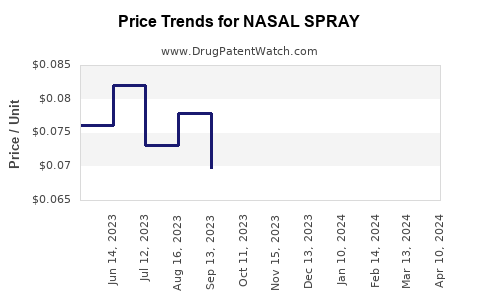Drug Price Trends for NASAL SPRAY
✉ Email this page to a colleague

Average Pharmacy Cost for NASAL SPRAY
| Drug Name | NDC | Price/Unit ($) | Unit | Date |
|---|---|---|---|---|
| NASAL SPRAY 0.05% | 45802-0410-59 | 0.07337 | ML | 2024-07-17 |
| NASAL SPRAY ORIGINAL 0.05% | 46122-0165-10 | 0.07337 | ML | 2024-07-17 |
| NASAL SPRAY 0.05% | 70000-0001-01 | 0.07337 | ML | 2024-07-17 |
| NASAL SPRAY 0.05% | 24385-0067-10 | 0.07337 | ML | 2024-07-17 |
| NASAL SPRAY 0.05% | 45802-0410-59 | 0.07430 | ML | 2024-06-19 |
| >Drug Name | >NDC | >Price/Unit ($) | >Unit | >Date |
Best Wholesale Price for NASAL SPRAY
| Drug Name | Vendor | NDC | Count | Price ($) | Price/Unit ($) | Unit | Dates | Price Type |
|---|---|---|---|---|---|---|---|---|
| NASAL SPRAY (OXYMETAZOLINE) | United Drug Supply, Inc. | 00113-0304-10 | 30ML | 2.56 | 0.08533 | ML | 2023-12-01 - 2028-11-30 | FSS |
| >Drug Name | >Vendor | >NDC | >Count | >Price ($) | >Price/Unit ($) | >Unit | >Dates | >Price Type |


